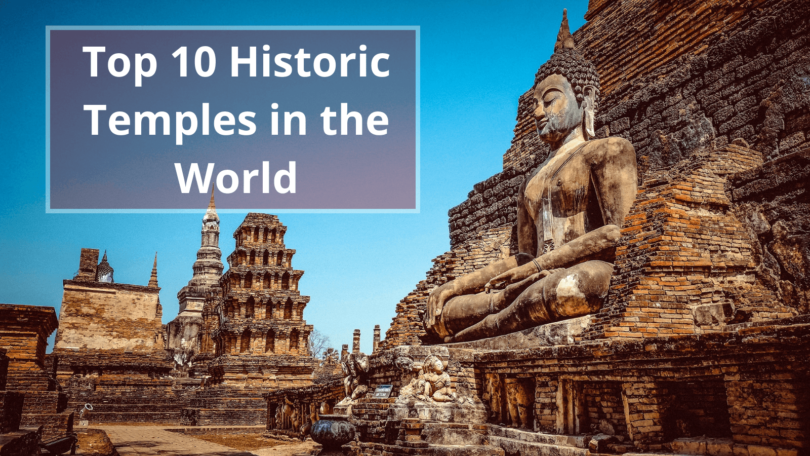In this article, we explore the top 10 historic temples from around the world, each with its own unique story to tell.
Temples are not just places of worship; they are living repositories of history, culture, and spirituality.
These magnificent structures often stand the test of time, bearing witness to centuries of human devotion and architectural excellence.
Historic Temples List
| S.no | Temples |
| 1 | Angkor Wat, Cambodia |
| 2 | Karnak Temple, Egypt |
| 3 | Parthenon, Greece |
| 4 | Borobudur, Indonesia |
| 5 | Temple of Heaven, China |
| 6 | Meenakshi Amman Temple, India |
| 7 | Temple of Luxor, Egypt |
| 8 | Shwedagon Pagoda, Myanmar |
| 9 | Temple of Apollo Epicurius, Greece |
| 10 | Chichen Itza, Mexico |
Historic Temples in the World
1. Angkor Wat, Cambodia

Angkor Wat in Cambodia is an architectural masterpiece and a UNESCO World Heritage Site. Built in the 12th century by King Suryavarman II, it is the world’s largest religious monument and originally served as a Hindu temple.
Later, it transformed into a Buddhist place of worship. Angkor Wat is renowned for its intricate carvings, stunning bas-reliefs, and towering spires, making it a symbol of Cambodia and a must-visit destination for history and culture enthusiasts.
2. Karnak Temple, Egypt

Karnak Temple in Egypt is a sprawling ancient complex located in Luxor, dedicated to the god Amun. This monumental structure was constructed over several centuries, with significant contributions from various pharaohs during the New Kingdom period.
Karnak is famous for its colossal columns, grand hypostyle hall, and intricate hieroglyphics, showcasing the architectural and artistic prowess of ancient Egypt. It served as a vital religious and administrative center, hosting elaborate festivals and rituals, making it a UNESCO World Heritage Site and a must-visit for history enthusiasts.
3. Parthenon, Greece

The Parthenon is one of the iconic Historic Temples located atop the Acropolis in Athens, Greece. Built in the 5th century BC, it is a remarkable symbol of ancient Greek civilization and an enduring masterpiece of classical architecture.
Dedicated to the goddess Athena, the Parthenon is renowned for its Doric columns, intricate friezes, and pediments adorned with sculptures. Despite centuries of wear and numerous transformations, it remains an influential cultural and historical monument. Today, it stands as a UNESCO World Heritage Site and a testament to the artistic and architectural achievements of the ancient Greeks.
4. Borobudur, Indonesia

Borobudur, located in Indonesia, is the world’s largest Buddhist temple and one of the most significant religious monuments globally.
Dating back to the 9th century, this UNESCO World Heritage Site is a masterpiece of Indonesian architecture. Its nine stacked platforms are adorned with intricate relief panels, telling the story of Buddha’s life and teachings.
The temple features 72 bell-shaped stupas, each containing a statue of Buddha. Borobudur is a place of pilgrimage and a stunning example of ancient Buddhist art and culture, making it a must-visit for travelers seeking spiritual and historical experiences.
5. Temple of Heaven, China

The Temple of Heaven, situated in Beijing, China, is a masterpiece of Ming Dynasty architecture and a UNESCO World Heritage Site. Built in the 15th century, this stunning complex served as a sacred site for emperors to conduct annual ceremonies and offer prayers for a fruitful harvest.
The Hall of Prayer for Good Harvests, with its iconic triple-tiered roof and wooden pillars, is a highlight of the temple complex. Surrounded by lush gardens and historical significance, the Temple of Heaven is a testament to China’s rich cultural heritage and an essential stop for history and architecture enthusiasts.
6. Meenakshi Amman Temple, India

The Meenakshi Amman Temple, located in Madurai, India, is a magnificent example of South Indian Dravidian architecture also, one of the Historic Temples in the history. Dating back to the 6th century, this temple is dedicated to the goddess Meenakshi and her consort, Lord Sundareswarar.
Its towering gopurams (ornate entrance towers), adorned with thousands of colorful sculptures, are a hallmark of the temple’s grandeur. The temple complex is a vibrant hub of religious and cultural activity, hosting festivals and rituals that draw devotees and visitors from around the world. The Meenakshi Amman Temple stands as a testament to India’s rich heritage and spiritual significance.
7. Temple of Luxor, Egypt

The Temple of Luxor, located in Luxor, Egypt, is a mesmerizing historical site from ancient Egypt. Built over several centuries, it is dedicated to the god Amun, his wife Mut, and their son Khonsu.
This temple complex boasts massive columns, grand courts, and beautifully preserved hieroglyphics, making it a testament to the architectural and artistic achievements of ancient Egypt.
The annual Opet Festival was held here, symbolizing the renewal of the pharaoh’s divine power. The Temple of Luxor, along with Karnak Temple, forms an essential part of Luxor’s renowned open-air museum, offering visitors a glimpse into Egypt’s rich history and culture.
8. Shwedagon Pagoda, Myanmar

The Shwedagon Pagoda, located in Yangon, Myanmar, is an iconic Buddhist stupa covered in shimmering gold leaf. It is believed to be over 2,600 years old, making it one of the oldest and most revered religious sites in the world.
The pagoda enshrines relics of four Buddhas, and its central stupa reaches a height of 99 meters (325 feet). Surrounded by smaller stupas, temples, and shrines, the Shwedagon Pagoda is a spiritual and cultural epicenter for the people of Myanmar and an awe-inspiring destination for visitors seeking a glimpse of the country’s rich heritage.
9. Temple of Apollo Epicurius, Greece

The Temple of Apollo Epicurius, located in Bassae, Greece, is a remarkable ancient Greek temple dating back to the 5th century BCE.
This well-preserved architectural marvel is renowned for its unique combination of Doric and Ionic styles. It was dedicated to Apollo Epicurius, the god of healing and the defender against epidemics, reflecting the ancient Greeks’ reverence for health and well-being.
The temple is recognized for its remote mountainous setting, intricate carvings, and the use of innovative construction techniques. It has been designated as a UNESCO World Heritage Site, contributing to our understanding of ancient Greek architecture and culture.
10. Chichen Itza, Mexico

Chichen Itza is an iconic archaeological site located in the Yucatan Peninsula of Mexico. This ancient Mayan city thrived from the 7th to the 10th century and is renowned for its stunning pyramids, particularly the Kukulkan Pyramid, also known as El Castillo.
Chichen Itza is a UNESCO World Heritage Site and a symbol of Mayan civilization’s advanced understanding of astronomy and mathematics. The site’s Ball Court, Temple of the Warriors, and intricate carvings are also notable attractions, drawing countless tourists and archaeologists eager to explore this rich historical treasure.
These historic temples are not only architectural marvels but also windows into the rich tapestry of human history and spirituality.
Visiting these sacred sites allows us to connect with the past and appreciate the enduring beauty of human creativity and devotion.








